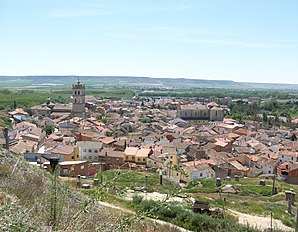Dueñas (Palencia)
| Dueñas municipality | ||
|---|---|---|
 Dueñas - town view
|
||
| coat of arms | Map of Spain | |

|
|
|
| Basic data | ||
| Autonomous Community : |
|
|
| Province : | Palencia | |
| Comarca : | El Cerrato | |
| Coordinates | 41 ° 53 ′ N , 4 ° 33 ′ W | |
| Height : | 700 msnm | |
| Area : | 124.35 km² | |
| Residents : | 2,612 (Jan 1, 2019) | |
| Population density : | 21.01 inhabitants / km² | |
| Postal code : | 34210 | |
| Municipality number ( INE ): | 34069 | |
| administration | ||
| Website : | Dueñas | |
Dueñas is a small town and a municipality ( municipio ) with 2,612 inhabitants (as of January 1, 2019) in the extreme south of the northern Spanish province of Palencia in the autonomous community of Castile-León . The historic center of the town has been recognized as a cultural asset ( Bien de Interés Cultural ) in the conjunto histórico-artístico category since 1967 .
location
Dueñas is located on the A-62 Autovía on the west bank of the Río Pisuerga and the Canal de Castilla on the eastern edge of the Tierra de Campos agricultural landscape at an altitude of approx. 700 m . The distance to the northern provincial capital Palencia is just under 20 km (driving distance); the city of Valladolid is just under 30 km southwest. The climate in winter is harsh, but in summer it is dry and warm; the rather sparse rain (approx. 430 mm / year) falls mainly in the winter half-year.
history
Already in ancient times, the place was strategically located on a connecting road between Burgos and Valladolid not far from the confluence of the Río Carrión and Río Pisuerga. The Visigoths also left a few evidence of their presence before the Arab-Moorish armies invaded the region in the 8th century. But already in the 9th century, the Christians conquered under Alfons III. the area temporarily back ( reconquista ) . At the end of the 10th century it came under Muslim suzerainty again as part of Almansor's advances , until it was finally conquered by Ferdinand I of León in 1064 . Alfonso VI granted the city certain freedoms and privileges ( foros ) in 1078 . In the 15th and 16th centuries it experienced its heyday.
Population development
| year | 1857 | 1900 | 1950 | 2000 | 2017 |
| Residents | 3,908 | 4,053 | 3,674 | 2,949 | 2,658 |
Because of the mechanization of agriculture and the abandonment of small farms, many workers and their families migrated to the larger cities in the 20th century ( rural exodus ); this resulted in a decline in purchasing power, which also triggered a population decline in the small town.
economy
The surrounding area of Dueñas is largely agricultural, with livestock traditionally playing a less important role; the place offered the necessary regional services in the fields of handicraft and trade. Today Dueñas belongs to the small wine-growing region of Cigales ; however, tourism only plays a subordinate role.
Attractions
- The Iglesia de Santa María de la Asunción is dedicated to the Assumption of Mary . It was built around the year 1200 - the middle apse and the northern side apse are still preserved from this time. The three in the form of a relay hall built naves already showing early Gothic ribbed vault . The church's greatest treasure is the Flemish-Spanish carved altar with scenes from the life of Jesus and Mary from the years 1510 to 1518. The choir stalls (sillería) were built around 1500; above there are several late Gothic wall graves. The small parish museum is housed in the sacristy; Particularly noteworthy is an Ecce Homo figure by Diego de Siloé from 1525.
- Another important church building belongs to the former Augustinian convent and dates from around 1600.
- The church of the Hospital de Santiago can also be visited.
- A granary (Pósito) from the 18th century is the most important civil building in the city.
- Surroundings
- Only about 200 m from the village are some storage cellars ( bodegas ) that have been driven into the crumbly rock .
- Approx. 3 km northeast of the small town is a Benedictine monastery , originally founded in the 7th century , which was converted into the newly founded Trappist Abbey of San Isidro de Dueñas in 1891 . The unadorned monastery building looks more like a barracks.
Web links
- Dueñas - photos + short information (spanish)
- Dueñas, sights - photos + information (arteguias, Spanish)
Individual evidence
- ↑ Cifras oficiales de población resultantes de la revisión del Padrón municipal a 1 de enero . Population statistics from the Instituto Nacional de Estadística (population update).
- ↑ Dueñas - climate tables
- ↑ Dueñas - population development
- ↑ Duenas - Church of Santa María de la Asunción






